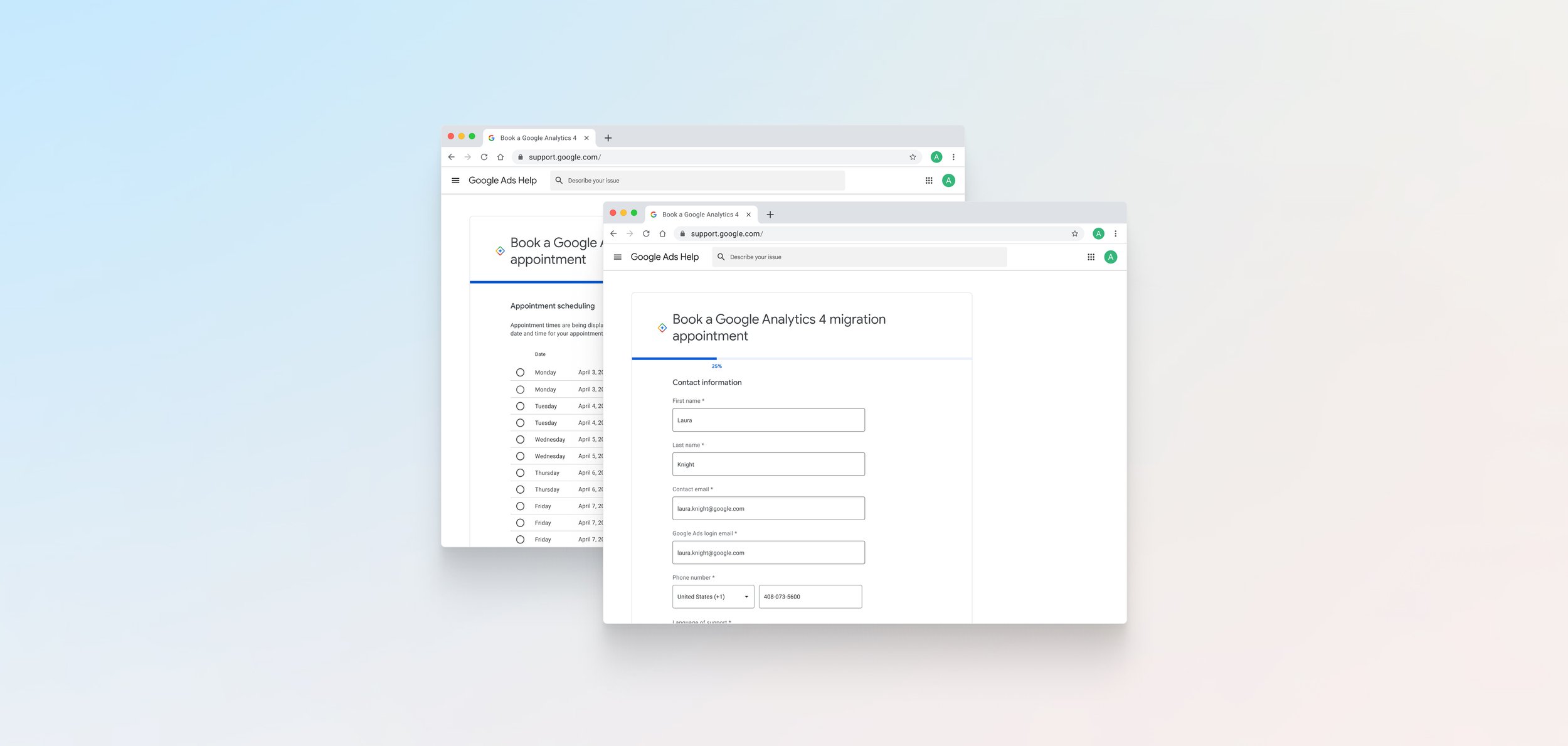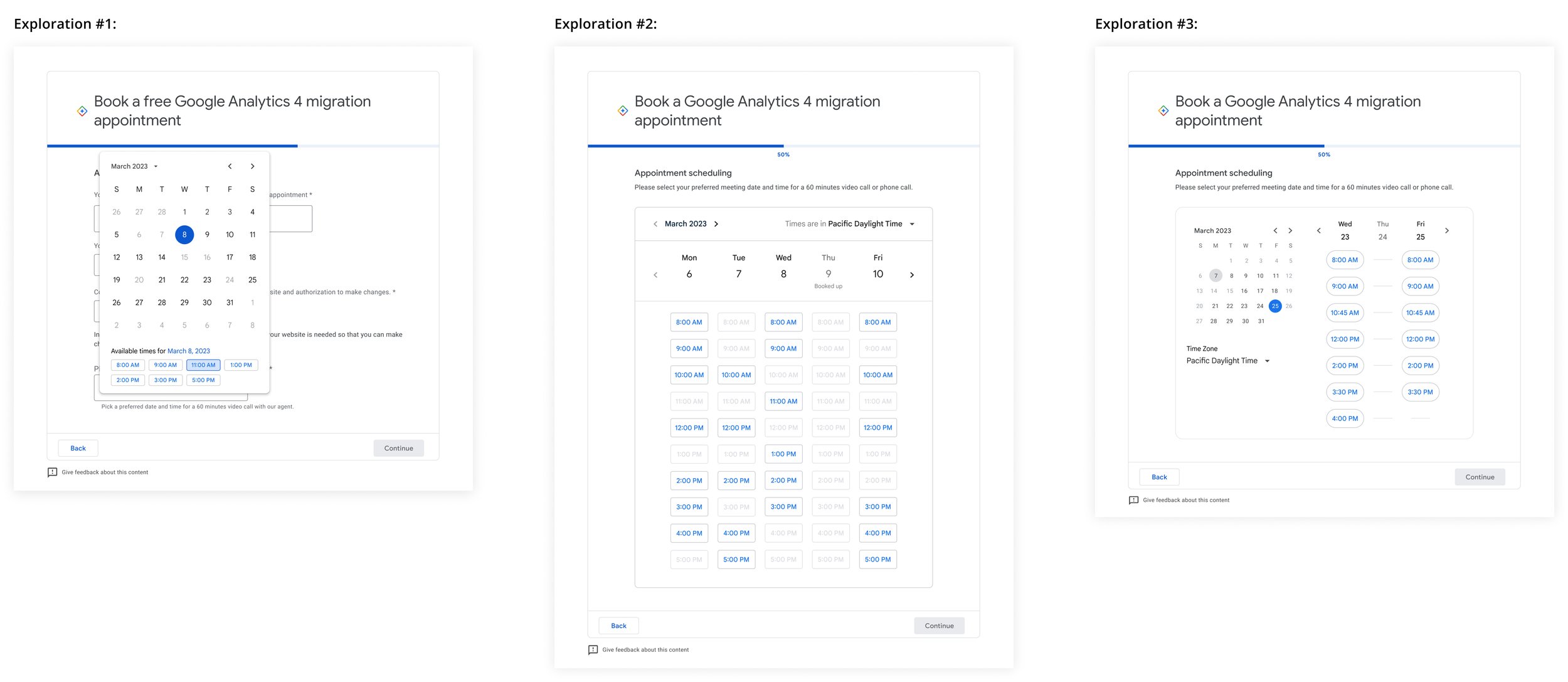
Google Analytics 4 Migration Appointment
An external appointment schedulers to efficiently connect advertisers that need migration support with the Tag Implementation team.
A project for Google
Role: Interaction designer
Responsibilities: UX design, visual design, usability testing, functional flow and specifications
Project team: Project manager, gCare team, UX writer, and engineers
Timeline: 1 month
Background
The vision of Supportal Services is to assist advertisers in discovering, learning, and accessing the services provided by Google teams at crucial moments. The migration to Google Analytics 4 (GA4) represents a pivotal stage in the advertiser journey. To prioritize this, we are adjusting our roadmap to ensure that advertisers are seamlessly connected with tag team specialists who can assist them with analytics migration. Our current channels, such as Sellers and troubleshooting teams, are unable to efficiently match advertisers with the appropriate tag implementation specialists.
To address this, we propose expediting the implementation of external appointment schedulers. This will facilitate efficient connections between advertisers in need of migration support and the Tag Implementation team, effectively eliminating the involvement of Sellers and Troubleshooting agents. By implementing this solution, the bottleneck in the process will be solely determined by the capacity of the Tag Implementation teams.
Phases
The implementation of the external appointment scheduler is divided into four phases, with my primary focus and contribution centered around V0.2 and MVP of the development process.
Restructuring Appointment Form
Regarding the V0.1 appointment form, using Composer was a quick solution to launch the GA4 migration session for Google customers. However, we have recognized that this approach is not efficient for the long term. After conducting observations, we identified several pain points experienced by both customers and agents:
Sub-optimal customer experience, leading to customer drop-off.
Lack of gating control, resulting in a high number of ineligible customers signing up for the GA4 migration session.
Lack of scheduling control, leading to longer communication time before appointments were scheduled.
Unprepared customers showing up for appointments, resulting in wasted time for both the customers and agents.
Based on these findings, we have made the decision to quickly change the form structure by utilizing our existing platform called AWF (Authorable Workflow). This transition aims to address the aforementioned problems and improve the overall experience.
User Flow
Scope of Work (v0.2)
To optimize the appointment form, I collaborated closely with a UX writer and content strategist. Together, we worked on restructuring the content to encapsulate the necessary customer information while ensuring a seamless user interaction. By leveraging their expertise in content strategy, we aimed to create a form that effectively communicates with users and collects the required information in a user-friendly manner.
CID selector - Set Expectations about Migration support + CID selector to validate eligibility. If a CID is ineligible, advertisers must be directed to a self-help resource.
Advertiser contact information - Name, email, Google Ads email, phone number, language of support, and website
Account information - Universal Analytics ID, Analytics setup type, and additional information
Appointment information - Show available appointment slots
Terms and conditions - Acknowledgement
Confirmation - A message to inform Advertisers that they will get a calendar invite in a few minutes.
Deliverables (vo.2)
Here are the key changes we have implemented:
Enhancing the customer experience by optimize the form to ensure a smoother user journey, reducing customer drop-off rates and increasing engagement.
Implementing gating control to prevent ineligible customers from signing up for the GA4 migration session, we will introduce a gating mechanism that verifies their eligibility before allowing them to proceed.
Streamlining appointment scheduling to minimize communication time between customers and agents, enabling faster and more efficient appointment bookings.
Introducing preparatory steps and resources to improve customer readiness, ensuring they arrive fully prepared for appointments and eliminating unnecessary wastage of time for both customers and agents.
1. Landing page + CID selector
3. Account information
5. Terms & conditions
2. Contact information
4. Appointment scheduling
6. Confirmation
Constraint
The primary limitation of AWF is its inability to generate information simontaneously on the same page where it affects the form's flow and grouping of information. For instance, the timezone selection is not grouped with the appointment scheduling page but placed on the contact information page instead. Considering our tight launch schedule, we have communicated this issue to our gCare team partners, and in collaboration with the AWF engineers, we will enhance the appointment scheduling experience in the MVP.
Here are some explorations of appointment widget for the MVP:
Impact
5,000 successful appointments - resulting in $85 million in revenue defense
This result has proven that the launch of V0.2 of the GA4 Migration Appointment Scheduling has successfully:
Connected advertisers to the appropriate tag implementation specialists.
Kept ineligible advertisers from signing up for appointments.
Given advertisers the freedom to schedule appointments by streamlining the process.
Prepared advertisers with requested information prior to appointments for a successful migration session with specialists.










